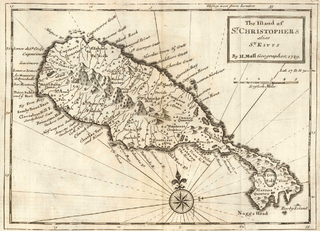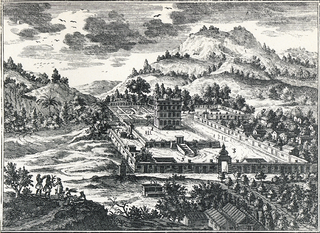
Saint Kitts and Nevis have one of the longest written histories in the Caribbean, both islands being among Spain's and England's first colonies in the archipelago. Despite being only two miles apart and quite diminutive in size, Saint Kitts and Nevis were widely recognized as being separate entities with distinct identities until they were forcibly united in the late 19th century.

Basseterre is the capital and largest city of Saint Kitts and Nevis with an estimated population of 14,000 in 2018. Geographically, the Basseterre port is located at 17°18′N62°44′W, on the south western coast of Saint Kitts Island, and it is one of the chief commercial depots of the Leeward Islands. The city lies within Saint George Basseterre Parish.
Phillippe de Longvilliers de Poincy (1584–1660) was a French nobleman and Bailiff Grand Cross of the Knights of Malta. He governed the island of Saint Christopher from 1639 to his death in 1660, first under the Compagnie des Îles de l'Amérique and later under the Knights of Malta themselves. Poincy was the key figure in the Hospitaller colonization of the Americas.

The British West Indies (BWI) were colonised British territories in the West Indies: Anguilla, the Cayman Islands, Turks and Caicos Islands, Montserrat, the British Virgin Islands, Antigua and Barbuda, The Bahamas, Barbados, Dominica, Grenada, Jamaica, Saint Kitts and Nevis, Saint Lucia, Saint Vincent and the Grenadines, British Guiana and Trinidad and Tobago. Other territories included Bermuda, and the former British Honduras.

Saint Christopher-Nevis-Anguilla was a British colony in the West Indies from 1882 to 1983, consisting of the islands of Anguilla, Nevis, and Saint Christopher. From 1882 to 1951, and again from 1980, the colony was known simply as Saint Christopher and Nevis. Saint Christopher and Nevis gained independence in 1983 as the Federation of Saint Kitts and Nevis, while Anguilla would remain a British overseas territory.

Sir Clement Athelston Arrindell was the first governor-general of Saint Kitts and Nevis, serving from 1983 to 1995, and also served as the country's final colonial governor, from 1981 to 1983.

The British Leeward Islands was a British colony from 1671 to 1958, consisting of the English overseas possessions in the Leeward Islands. It ceased to exist from 1816 to 1833, during which time it was split into two separate colonies. It was dissolved in 1958 after the separation of the British Virgin Islands, and the remaining islands became parts of the West Indies Federation.

The monarchy of Saint Kitts and Nevis is a system of government in which a hereditary monarch is the sovereign and head of state of Saint Kitts and Nevis. The current monarch of Saint Kitts and Nevis, since 8 September 2022, is King Charles III. As sovereign, he is the personal embodiment of the Crown of Saint Kitts and Nevis. Although the person of the sovereign is equally shared with 14 other independent countries within the Commonwealth of Nations, each country's monarchy is separate and legally distinct. As a result, the current monarch is officially titled King of Saint Christopher and Nevis and, in this capacity, he and other members of the royal family undertake public and private functions domestically and abroad as representatives of Saint Kitts and Nevis. However, the King is the only member of the royal family with any constitutional role.

The Hospitaller colonization of the Americas occurred during a 14-year period in the 17th century in which the Knights Hospitaller of Malta, at the time a vassal state of the Kingdom of Sicily, led by the Italian Grand Master Giovanni Paolo Lascaris, possessed four Caribbean islands: Saint Christopher, Saint Martin, Saint Barthélemy, and Saint Croix.
Sir Probyn Ellsworth Inniss MBE was the Governor of Saint Christopher-Nevis-Anguilla from 1975 to 1980, and then, following the separation of Anguilla, the Governor of Saint Christopher and Nevis from 1980 to 1981.

Sir Milton Pentonville Allen OBE was the Governor of Saint Christopher-Nevis-Anguilla from 1969 to 1975. He was a native of Saint Kitts, and was a journalist and politician before being appointed governor.

The Château de la Montagne, also known as the De Poincy Château or the Château de la Fontaine, was a fortified palace in Saint Peter Basseterre Parish on the island of Saint Kitts. It was built in the 1640s by Governor Phillippe de Longvilliers de Poincy, and it remained standing until it was destroyed in an earthquake in 1689. Built in the Baroque style, the château was regarded as one of the finest houses in the Caribbean.
Claude de Roux, chevalier de Saint-Laurent was a French soldier, a chevalier of the Knights Hospitaller, who was governor of the colony of Saint Christophe on Saint Christopher Island from 1666 to 1689. He took office in the Second Anglo-Dutch War (1665–67), when the French expelled the English from the island, and left office early in the Nine Years' War (1688–97), when the English expelled the French from the island.
Charles de Sales was a French soldier, a chevalier of the Knights Hospitaller, who was governor of the colony of Saint Christophe on Saint Christopher Island from 1660 to 1666 during a period when the island was divided between the French and the English.
Robert de Longvilliers de Poincy was a French local governor of Saint Christophe and Saint Martin in the French Antilles. His uncle, Phillippe de Longvilliers de Poincy, was commander of the French colonies in the Antilles from 1639 to 1651, then commander of the colonies of Saint Christophe, Saint Croix, Saint Barthélemy, and Saint Martin for the Knights of Malta. Longvilliers reestablished French control of the northern part of Saint Martin after the Spanish withdrew and the Dutch tried to take over the whole island.














